Escene ES330-N / ES330-PN IP Phones Review with Escene ESM 32 Expansion Module
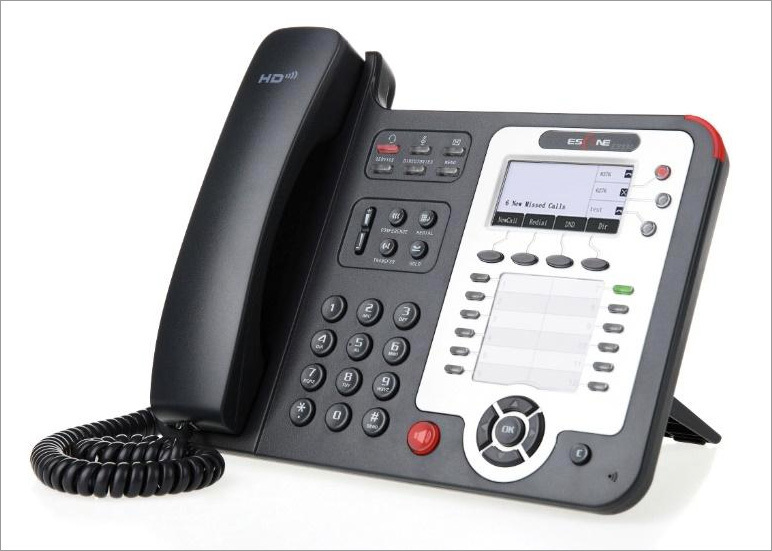 Phone Escene ES / GS 330 flagship in the corporate lineup. The three lines, the integrated BLF panel, the ability to connect additional expansion panels, make the ES / GS 330 a powerful communication tool. The device will be an excellent solution for anyone who is faced with the need to quickly switch calls or work with several lines at the same time.
Phone Escene ES / GS 330 flagship in the corporate lineup. The three lines, the integrated BLF panel, the ability to connect additional expansion panels, make the ES / GS 330 a powerful communication tool. The device will be an excellent solution for anyone who is faced with the need to quickly switch calls or work with several lines at the same time.The phone in question is an advanced model in the Escene range of corporate IP phones . Compared with the younger model Escene ES320, the device has an additional third line, as well as the ability to connect up to 6 Escene ESM 32 expansion consoles. You can connect a headset to the phone in two ways. The older model of the phone in question can be attributed to the model Escene ES410 , which we described in one of the previous reviews. The company introduced three models: Escene ES330-PN devices with PoE support (powered over Ethernet) and Escene ES330-N without PoE support (equipped with the Escence AD200 power supply unit) have 100 Mb / s Fast Ethernet network interfaces, the Escene GS330-N model has received network Gigabit Ethernet interfaces operating at speeds up to 1 Gb / s and PoE support. For a model with a PoE power supply unit is not included in the kit, but if necessary it can be purchased separately. This is where the differences between the models end.
Special features
- Part of a single corporate level lineup.
- High quality body materials.
- Large and clear graphic screen.
- High ergonomics.
- Adjustable stand and wall mounting option.
- Suitable for equipping the workplace of the secretary.
- Suitable for contact center operations.
- Simplicity of setup due to the clear interface.
- Russified web-interface and on-screen menu.
- The ability to fully customize the phone using the screen and buttons, including SIP accounts.
- Ability to adapt the phone to work with SIP-compatible equipment.
- The functionality is more than most of the IP PBX and telecom operators currently support.
Functionality
')
- Direct SIP connection to Virtual IP PBXs (for example, Broadworks, MFI RTU) and to office IP PBXs (for example, Asterisk, 3CX IP PBX, Avaya IP Office).
- Two Ethernet ports (PC / LAN) with VLAN support and the ability to work in the switching or routing mode.
- Easy installation and operation, advanced configuration options (including SIP and DVO functions) via the on-screen menu or via the web interface.
- Support up to three simultaneous calls on three independent SIP accounts (SIP accounts).
- Adaptation for the operator in the contact center (ergonomics, an additional RJ-9 connector for the headset of the operator of the contact center).
- Full duplex speakerphone, caller ID, call hold, call transfer and call forwarding, as well as other advanced features.
- High definition audio support Voice HD (G.722 codec).
- Built-in VPN client.
- Encryption of SIPS signaling and SRTP traffic media.
- Support for a corporate notebook using the LDAP or XML protocol or a personal notebook.
- Russified on-screen menu and web-interface phone.
Specifications
VoIP
- RFC 3261 standard SIP server, Asterisk, Avaya, Cisco, Broadsoft, RTU MFI, 3CX IP PBX, Panasonic SIP-PBX and others.
- Encryption of SIPS signaling traffic and SRTP media traffic.
- Audio codecs: G.711 u / a, G.722 (HD Voice), G.729a, G.723.
- QoS: TOS, Jiffer Buffer, VAD, CNG, G.168 (32ms).
- DNS SRV support.
- Three SIP accounts with the possibility of registration on two independent SIP servers and the possibility of automatic switching in case of loss of registration.
- Three simultaneous calls to the phone from any of the three SIP accounts.
Data transfer
- 2 * RJ45 10 / 100M Ethernet interfaces (LAN / PC) for the model Escene ES330-PN and ES330-N).
- 2 * 45 10/100 / 1000M Ethernet interfaces (LAN / PC) for model GS330-P
- VLAN / QoS support.
- IP addressing: DHCP client or static IP destination.
- Built-in VPN client L2TP or SSL VPN.
- Network protocols HTTP, BOOTP, FTP, TFTP, IEEE 802.1Q, IEEE 802.1X.
Physical parameters
- Monochrome LCD screen with backlight and the size of 128 * 64 characters with white backlight.
- 2 additional headset jacks - connection is supported in one of two ways: using 3.5 mm Jack jacks or an RJ-9 connector.
- Line status indicator (two-color LED).
- Full duplex speaker and handsfree microphone.
- Three line selection buttons 1-3 with light indication of the line status.
- Buttons to adjust the volume of the phone / ring signal.
- 4 multifunction buttons below the screen.
- 12 programmable buttons that can operate in BLF mode, speed dial (number, prefix or SIP URI) or DTMF tone transmissions.
- 6 navigation multifunction buttons (4 navigation buttons, the “OK” button and the button for deleting the “C” symbol).
- Buttons of additional services: conference, transfer, hold and redial.
- Speakerphone button with light indication.
- Button "Mute microphone" with light indication.
- Button "Voicemail" with light indication.
- Button to switch to a headset with light indication.
- Button "Menu" .
- Button "Service" .
- “Directories” button for access to directories.
- Connector for RJ-9 tube connection.
Additional services (additional features)
- Waiting for a second call, a queue (if it supports an IP PBX), call transfer, call forwarding, call hold, call pickup, callback, call repetition, auto answer.
- Speed dialing, button to start recording a conversation using the old code (if it supports IP PBX).
- BLF ( Busy Lamp Field )
- Multilateral conference (if supports IP PBX), 3-way conference on the phone.
- Do not disturb (DND).
- Voice mail (if the function is supported by IP PBX).
- Personal note book, corporate note book (LDAP or XML).
Control
- Protocols update: HTTP / TFTP / (PnP auto-tuning) PnP auto-provision.
- Configuration: via the phone's on-screen menu / web-interface / auto-provision.
- Debugging: telnet / phone screen / web-interface.
Nutrition
- Adapter model AD300 (AV 220/110 Volt, output DC 12 Volt / 1A).
- Power Over Ethernet (IEEE 802.af) LAN port - for modification of Escene ES330-PN and GS330-P.
- USB powered via USB-AMAM cable (“dad” - “dad”). For example, for charging smartphones.
Package, appearance and packaging
Packaging
The phone is delivered in a cardboard box that shows the company logo, on the side of the package there is a sticker with the model number and barcode of the device.
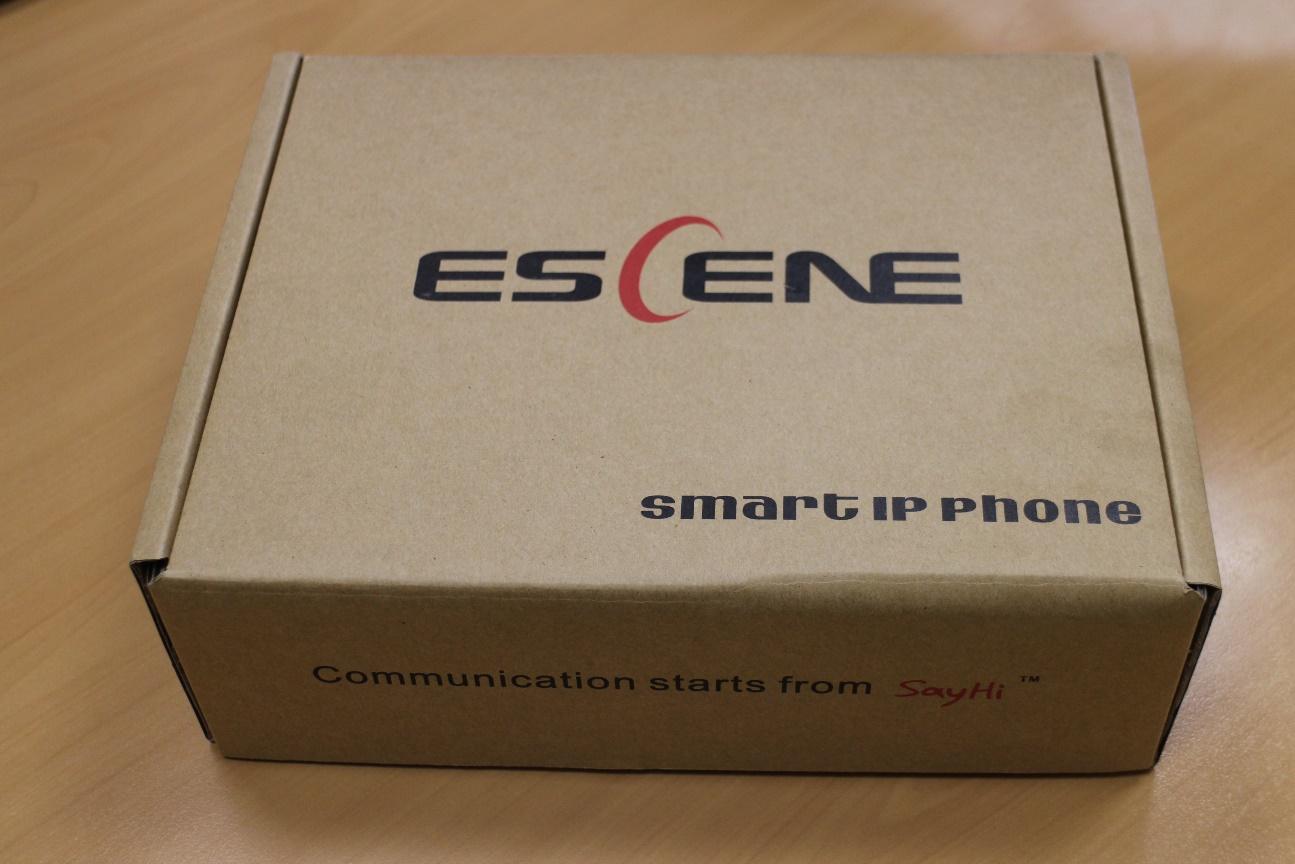
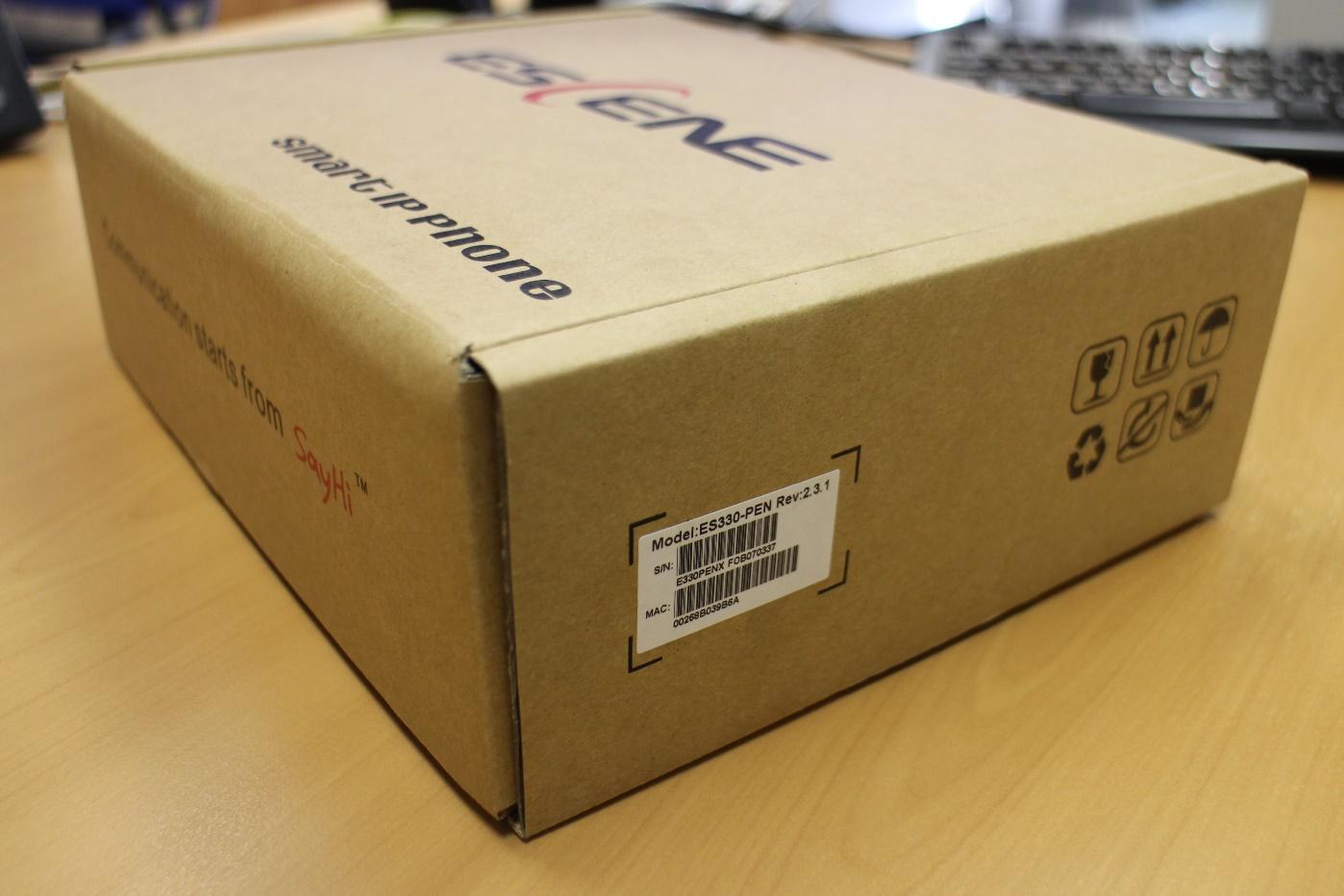
Phone kit
Inside the phone is neatly packed, there is nothing superfluous in the box. Obviously, this equipment reduces the cost of the phone.

The box contains standard equipment, which includes:
- Telephone set.
- Handset.
- Handset cord.
- RJ45 patch cord to connect to the network.
- Instruction and warranty card.
- Power supply Escence AD300 only for Escene ES330-N without PoE.
The delivery package for the Escene ES330-PN model is missing the Escence AD300 power supply unit (12 volts), it must be ordered separately.
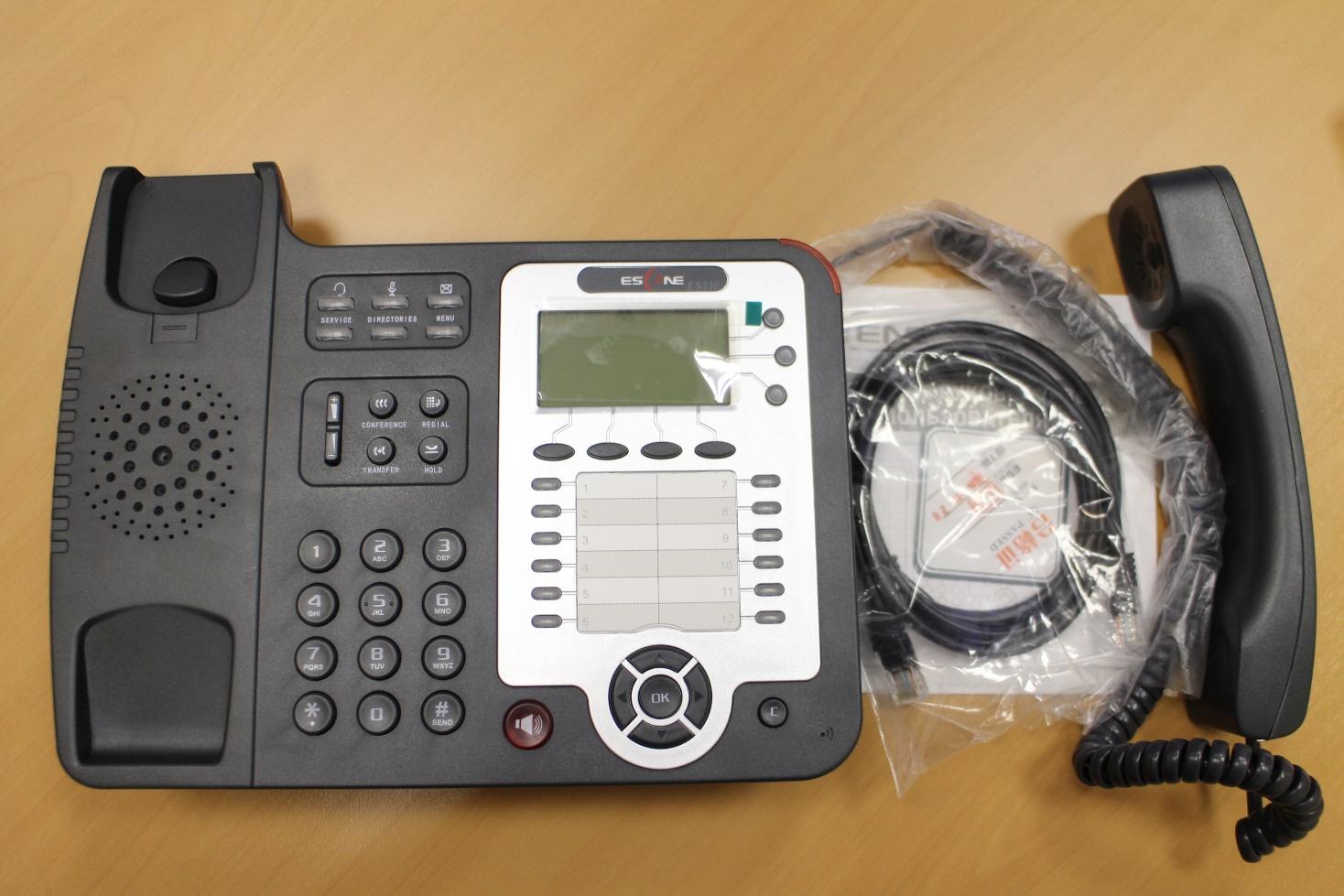
Conventionally, the buttons on the phone can be divided into 5 blocks.

The first block is the management of the service functions of the phone.
- Button "Menu" to access the on-screen menu.
- The “Service” button opens and closes the service menu.
- The "Directories" button allows you to access the phone's address book or one-touch call logs.
There is a separate voice mail call button with an envelope image, if there are unread messages in the voice mail box, the button lights up in red. A very useful button (the headset icon is shown above it) to switch to the headset and back, the button also has a light indicator, which allows the operator to control whether the headset is on or off. Also on the panel is a separate microphone mute button, if the microphone is turned off, the button is lit in red.
The second block is the management of additional functions.
Here are all the necessary buttons, just the ones that are used most often:
Conference - creation of a 3-way conference (initiator, and two participants). Creating a conference with a large number of participants requires the support of such a function on an IP PBX.
Transfer - call transfer during a call.
Hold (Pickup) - during a call, when you press the button, the call will be put on hold.
Redial - to redial the last number.
There are also two buttons for adjusting the phone / ring volume.
The third block is the management of lines and multifunctional buttons on the screen.
The phone has three independent SIP accounts (three SIP lines). By default, outgoing calls are established from line 1, if, of course, it is set up, if necessary to make a call from line 2 or 3, you need to click on the line button, then dial the number — the phone will send the call through the selected SIP account.
The phone can accept three simultaneous calls (but no more than two per SIP account). Line buttons 1-3 there is a light indication, when a call arrives, the diode of the line on which the call is being received flashes. If the line is busy, the line button is lit in red; if it is flashing, an incoming call has arrived. If the line is green, an active call is on the line; if it is flashing, the call is held on the line.
Each of the multifunctional buttons displays the function currently active, for example: New call, end call, Do Not Disturb, Call Transfer and others.
The fourth block - 12 programmable buttons.
The buttons can work in BLF mode, speed dialing (number, prefix or SIP URI), or DTMF tone transmissions. If we are talking about dialing a prefix, this function differs from dialing that the saved combination is automatically dialed, but the block of digits is not sent from the phone to the IP PBX - the phone is waiting for the dialing of the remaining digits of the number.
The BLF ( Busy Lamp Field ) feature allows you to monitor the current status of other subscriber lines in real time, as well as intercept calls destined for other subscribers. When the button is in BLF mode, if the button is red, the line is busy, if it is green, the line is free.
The fifth block is multifunctional navigation keys.
The block is used primarily for easy navigation through the menu, the “C” button is used to delete a character. Using the Up and Down buttons, you can adjust the ring volume or the volume of the phone during a call.
The panel has a separate large red button - “Hands-free”, which allows you to turn on or off the speakerphone (speakerphone), it is full-duplex in the phone. When the speakerphone is working, a red indicator lights up on the button.
On the back of the phone is a standard sticker with the model number, serial number and MAC address.
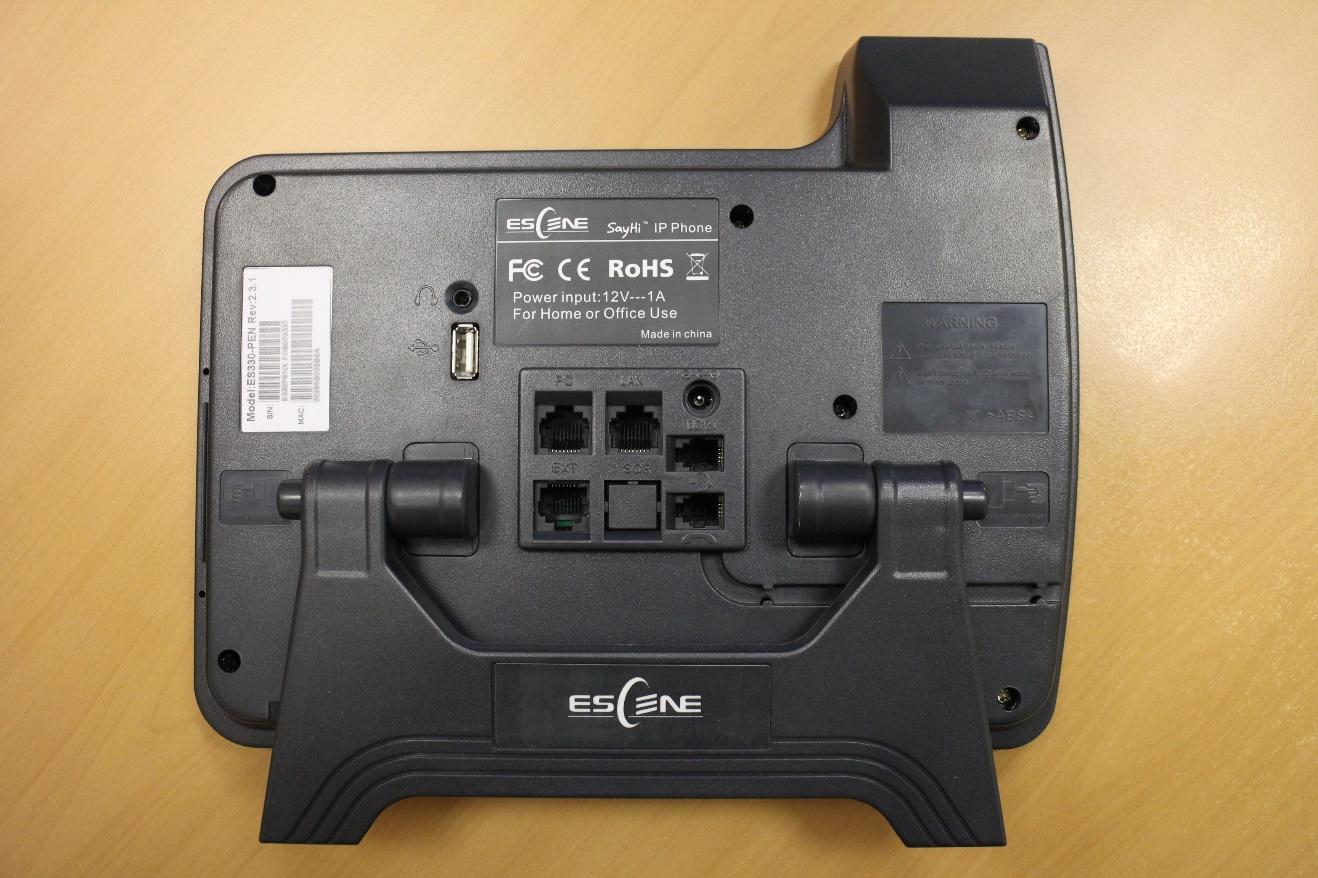
The model is equipped with a swivel stand, with which you can choose a convenient angle of the phone, you just need to press the buttons on the sides of the stand and set the desired angle. For mounting on the wall, it is enough to bend the stand up to the stop, for installation in the stand there are two holes with which you can mount the phone on the wall. The mounting holes are sealed with an Escene label.
Phone Interfaces & Connectors
The first photo shows a block of interfaces. For AC power using a power adapter, there is a 12-volt jack on the panel, two headset connectors, and a tube with an RJ-9 jack. Two Ethernet interfaces - PC for connecting the phone to a computer and LAN for connecting to a local network and power over PoE (for Escene ES330-PN or GS330-N model).
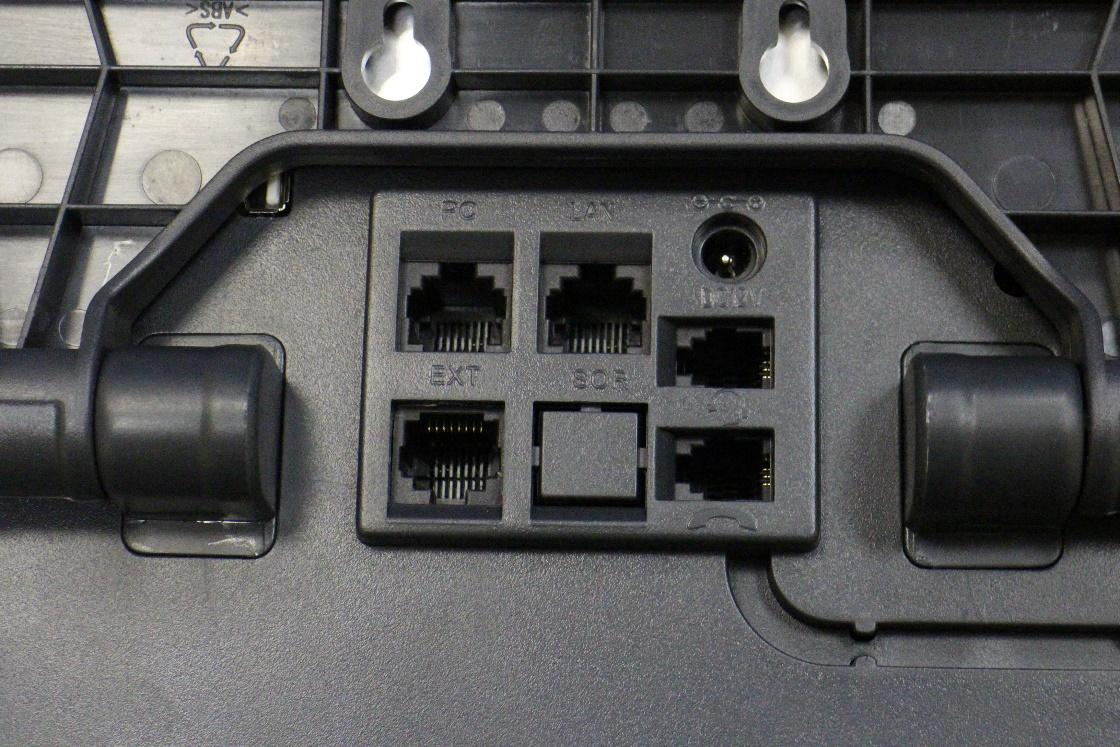
The EXT connector is designed to connect the module (console) of the Escene ESM 32 extension. Up to 6 such modules can be connected to the phone. Expansion module - a console with 32 programmable buttons connected to the phone. Each button can be programmed to monitor the status of any SIP IP PBX line in BLF mode (busy / free / incoming call) or used for speed dialing, DTMF combination, dialing prefix or calling by SIP URI address. The console is an indispensable tool for improving the performance of employees who work with a large number of calls. The important advantages can also be attributed to the lack of need for an additional power source for the console - all 6 expansion modules receive power from the phone.
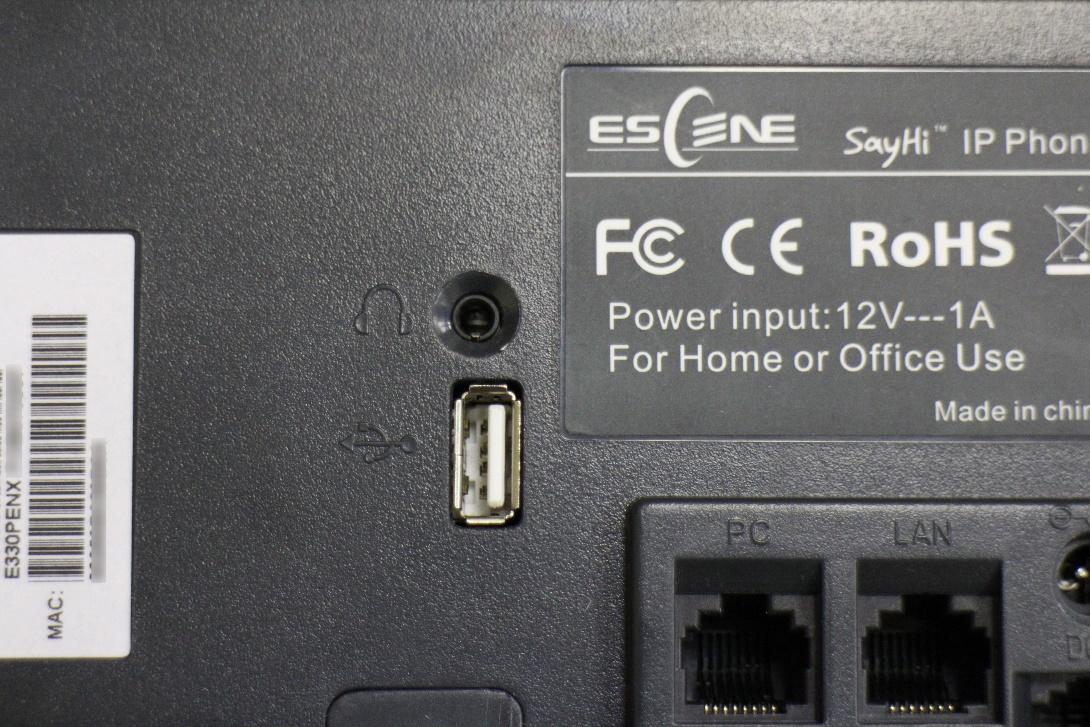
On the back there are jack jack 3.5 mm and USB. Jack 3.5 mm jack is used to connect the headset. This is extremely convenient, since many headsets have such a connector. The image shows connectors for wall mounting the phone on the wall.
USB-connector can be used to power the phone via USB cable, instead of PoE or power supply. To do this, you need a USB cable type AMAM, that is, "dad-dad" his image is presented in the figure below.
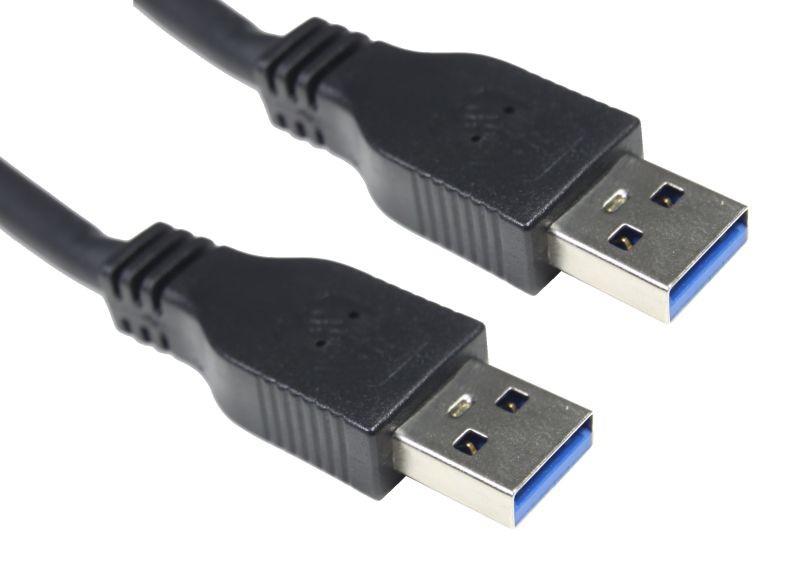
Here is the back of the phone with the wires connected:

This is how the phone looks assembled, high-quality plastic, the screen backlight is not very bright, but bright enough to read messages on the screen without difficulty.
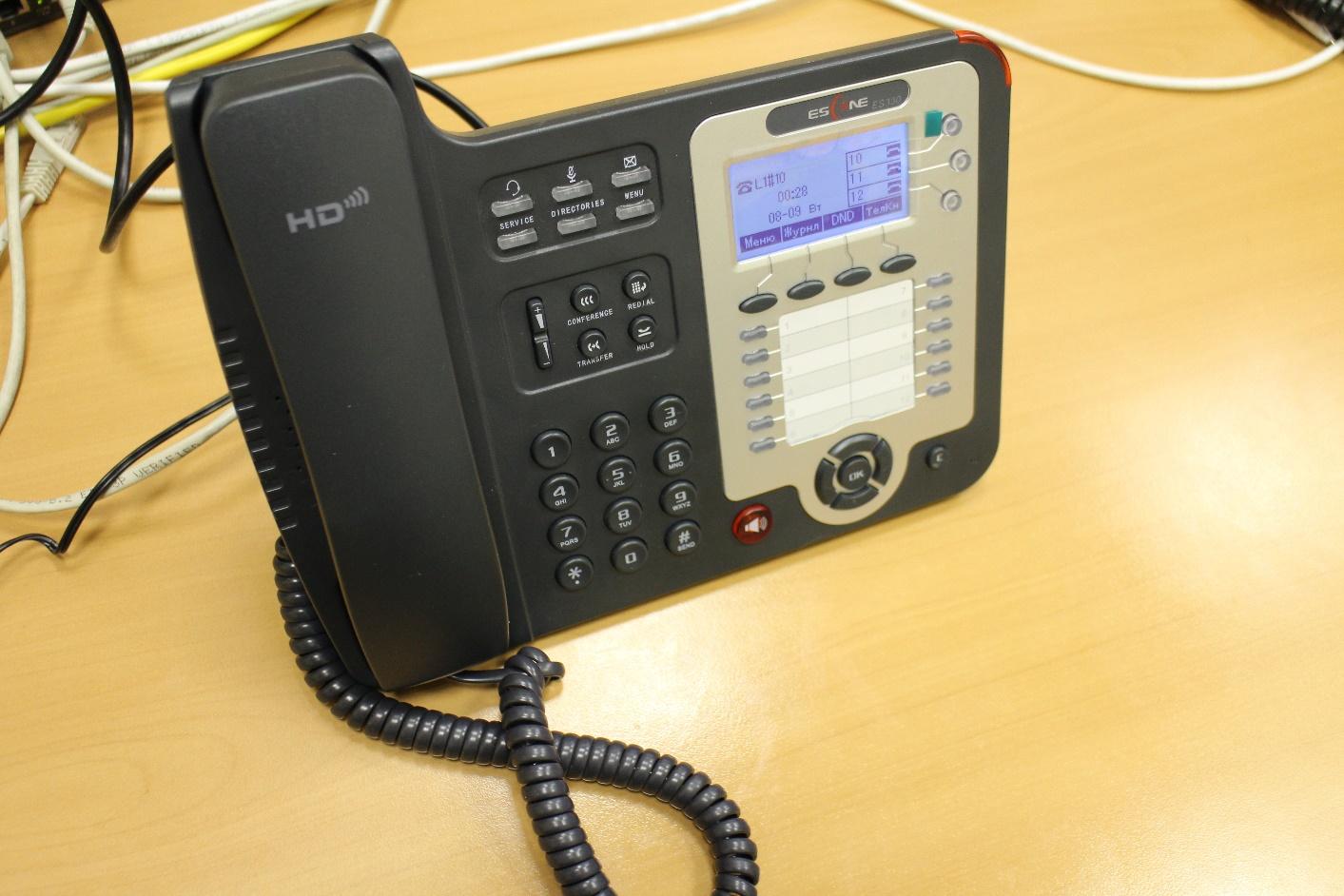
It is worth noting a nice screen with good resolution. The phone has a monochrome LCD screen with backlight size 128 * 64, not large, but its size is enough to easily read the information from the screen.
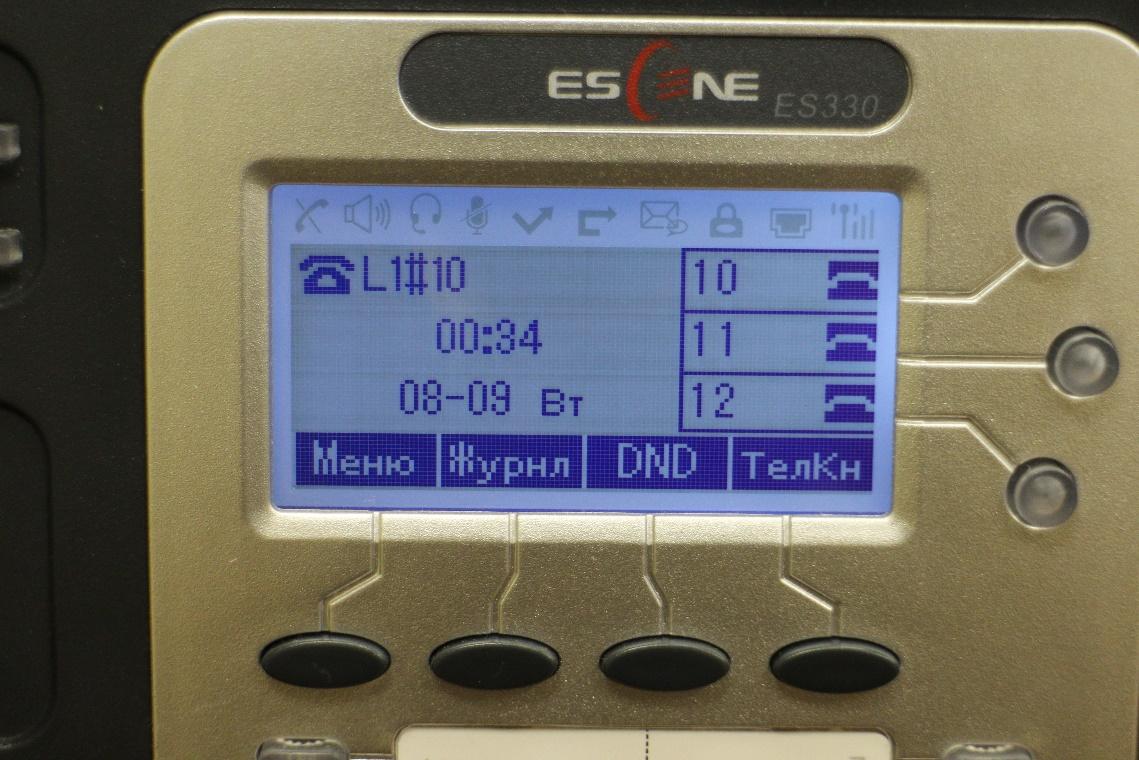
This is how the phone screen with the registered line in Russian looks. “L1 # 10” is an arbitrary label that is configured in the “SIP Accounts” menu and is called “Label” .
Dialing a number. When dialing a number, the button of the line through which the number is dialed lights up in red.

Incoming call. The button of the line to which the call came flashes in red.

State of conversation. During a call, the line button is green.
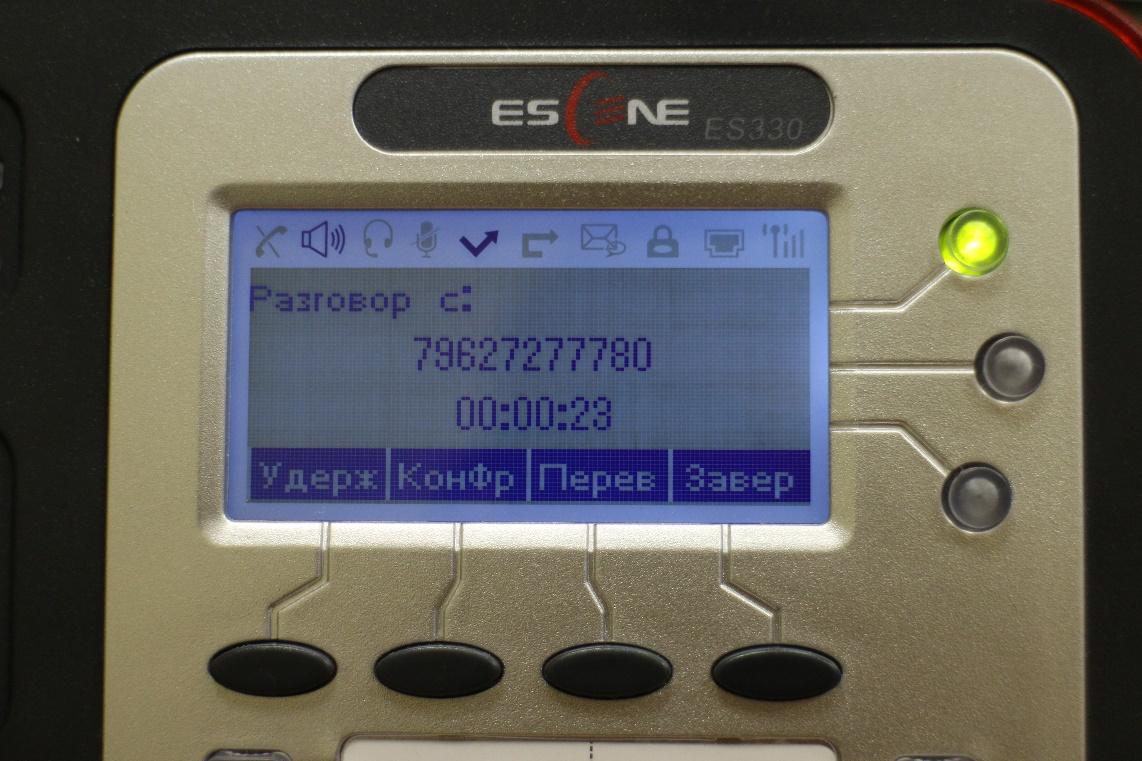
Call logs.

View of the menu on the phone screen.
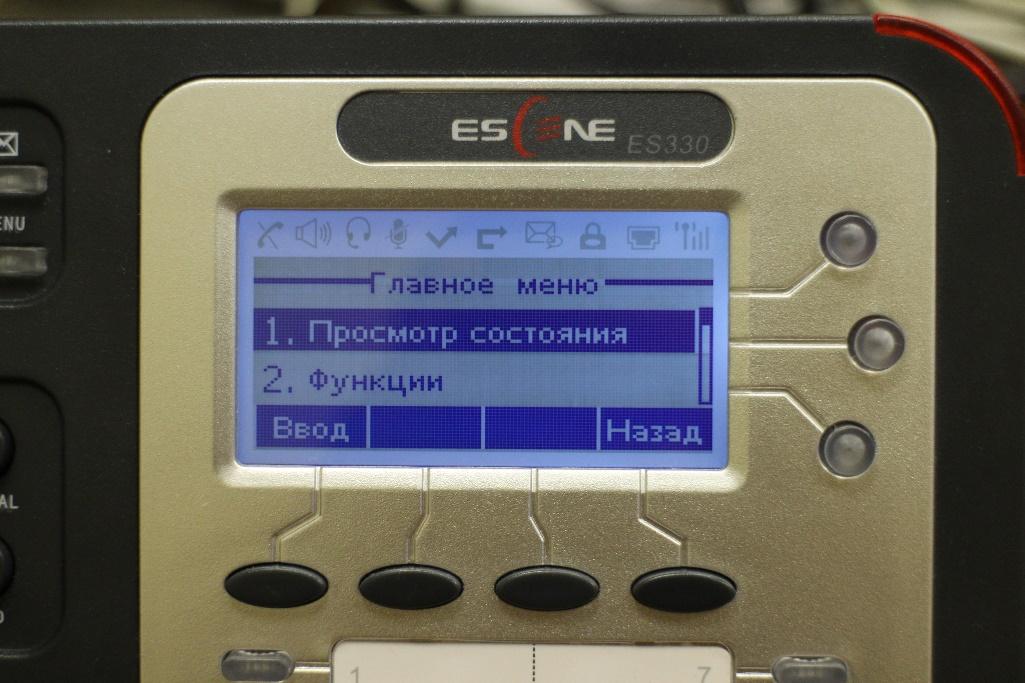
Expansion panel in BLF mode. In the photo below, in the BLF mode, 6 lines are working, 1, 3 and 4 lines are busy - the diodes are lit in red. On line 2 incoming call - the diode flashes red. Lines 5 and 6 are free - the diodes are green. The remaining lines are registered as speed dial, DTMF, dial prefix and SIP URI - in this mode the line diodes are canceled.
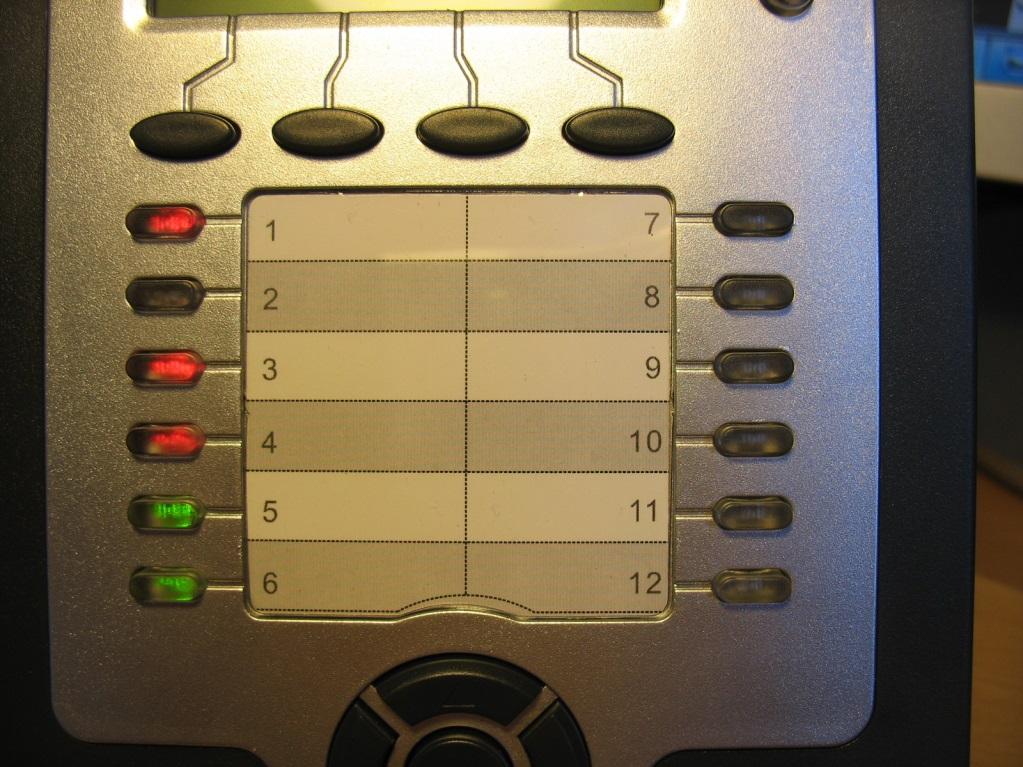
Escene ESM 32 Expansion Module
Expansion module - a console with 32 programmable buttons connected to the phone. Each button can be programmed to monitor the status of any SIP IP PBX line in BLF mode (busy / free / incoming call) or used for speed dialing, DTMF combination, dialing prefix or calling by SIP URI address. The console is an indispensable tool for improving the performance of employees who work with a large number of calls. The important advantages can also be attributed to the lack of need for an additional power source for the console - all 6 expansion modules receive power from the phone.
As described above, up to 6 external expansion modules can be connected to the phone, we will take a closer look at the console.
The device comes in a compact box.

The delivery package includes an expansion module, a metal bracket with four screws for securely fastening the phone with an expansion module, a patch cord with RJ-45 connectors for connecting the console and the phone, and a warranty card.
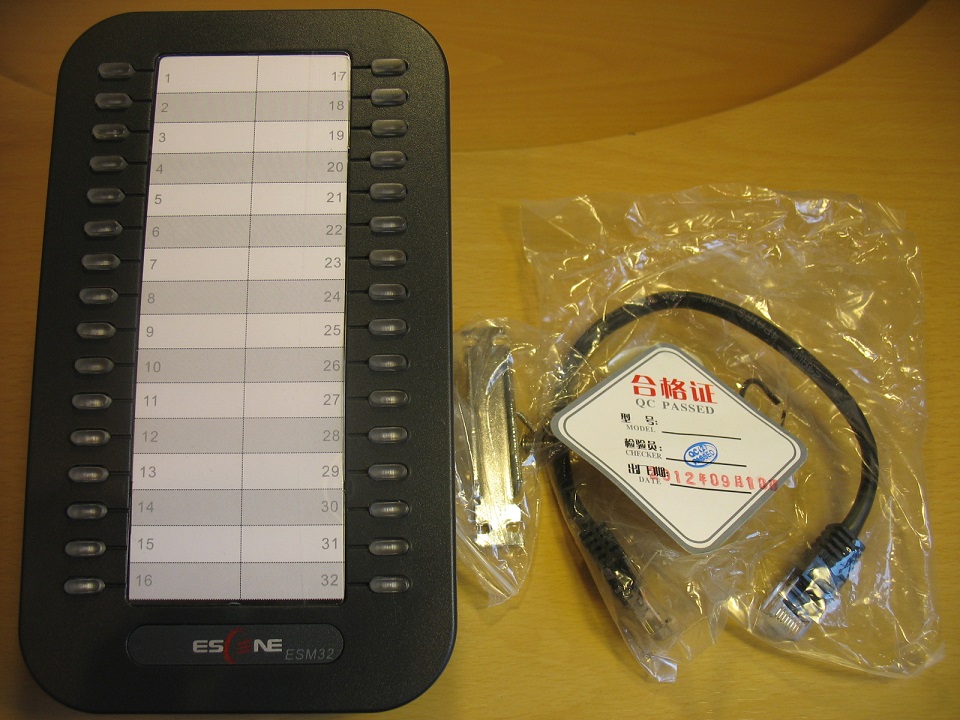
On the rear panel are two connectors:
- IN is the input interface for connecting the phone and the extension console. In the case of connecting the first expansion module, you must connect this connector to the EXT connector on the back of the IP phone using a patch cord.
- OUT - output interface for connecting the next expansion module.
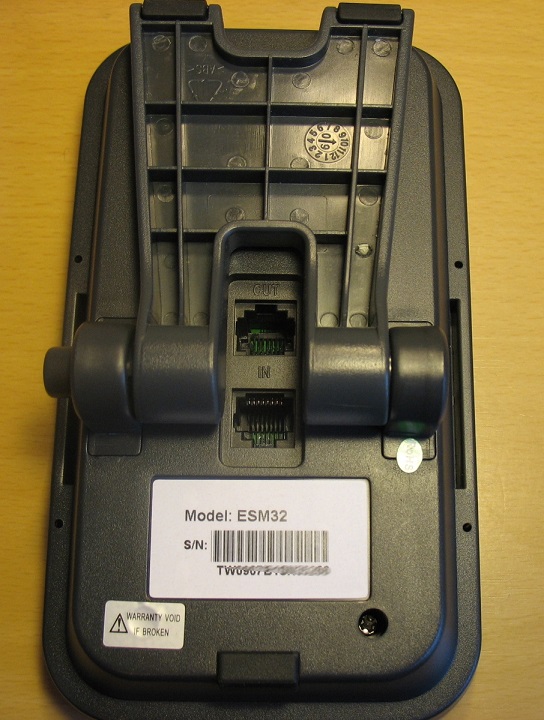
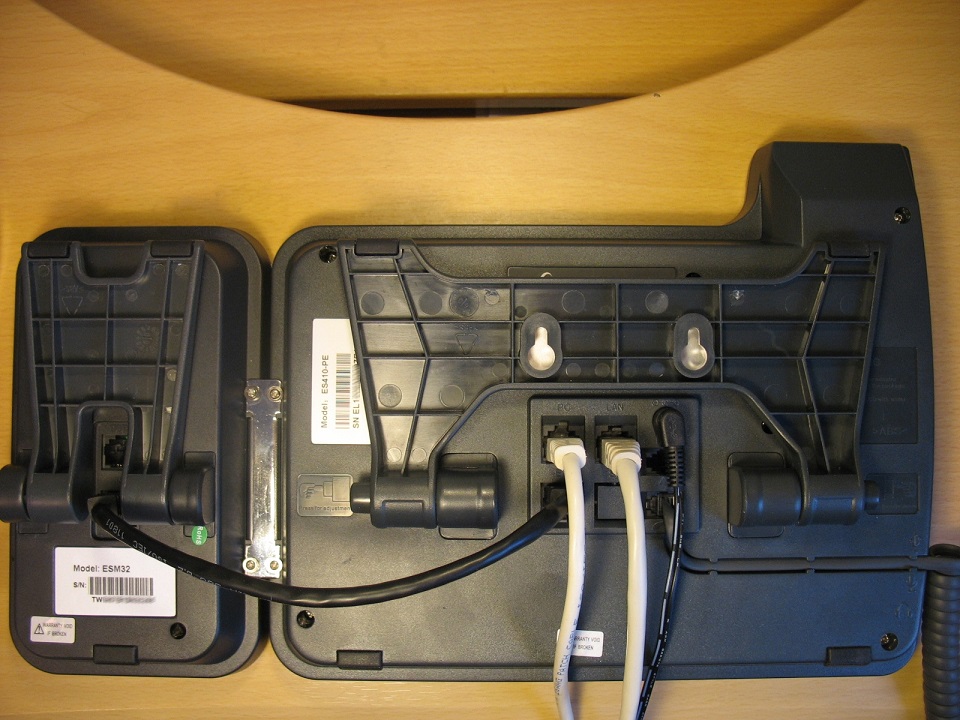
This is the look of the phone and the panel with the connecting bracket installed. To fix it you need to tighten the four screws, it can be seen in the photo.
After connecting the cable to the expansion module, to activate it, you need to restart the phone or open the menu — the Menu button on the telephone panel, then button 2 - “Functions”, then button 9 - “Expansion Module”, then press the button from “1” to "6", which corresponds to the number of the expander that needs to be detected. For example, pressing the "1" button initializes the first expansion module.
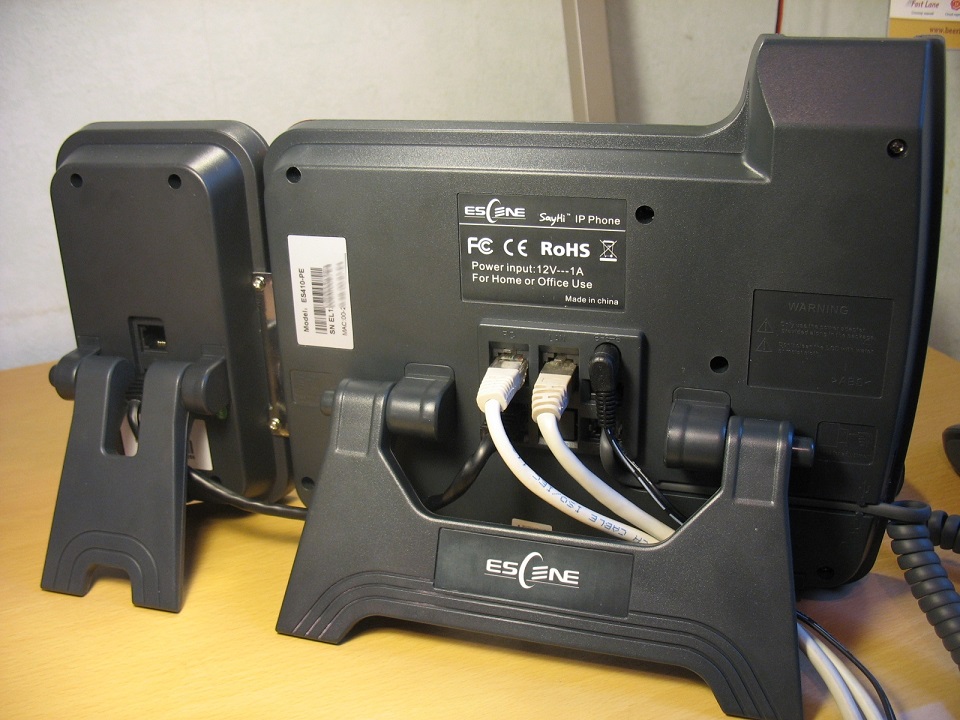
Expansion module and telephone on the table. The back stand of the module is fixed in the same way as the phone and therefore they stand exactly and are equally adjustable in height, the wires do not interfere. The design itself turned out to be reliable, there are no backlashes between the phone and the module.
The panel is successfully combined with the design of the phone of the same size and shape, has compact dimensions and conveniently located buttons, the size and location of the buttons makes it easy to accurately "get" into the right one.
Initial phone setup
The phone can be configured either using the phone menu or using the web interface. Unlike most phones from other manufacturers, which leave a minimum of settings in the phone menu and a greater number of them only through the web interface, the Escene developers decided to make accessible from the phone menu, in addition to the standard settings, settings related to SIP accounts (SIP accounts) ).
Such a move is fully justified, in some cases, you can configure the phone faster. In addition, sometimes there may be problems with access to the phone through a web-interface or it may be necessary to explain to an employee remotely how to reconfigure his phone. It will be easier for an unprepared person to use the phone menu, rather than a web interface.
Initial setup using phone buttons
So, we turned on the phone, connected the LAN port to the local network that has access to the IP PBX. Employee's computer through the cable connected to the PC port.
Now we need to include the Russian language in the menu:
Press the "Menu" button or the "OK" button, it is located in the middle of the navigation button block, a menu will open. Use the “Up” or “Down” navigation buttons to navigate the menu, press the corresponding button on the phone’s dialer or softkey (for example, “Enter” or “Select”) to select a menu item, use the “C” button to return to the previous item .
Next, press the number 3 (or the “OK” button), which corresponds to the choice of the “System Settings” menu, then select “Phone Setting” (number 3), then “Language” (number 1), using the up or down buttons Down "select" Russian "and click" OK "
Then press the "C" button until you exit the menu.
Now you need to configure the network settings:
Click "Menu" (or "OK"), then select the menu "System Settings" (or press number 3), number 2 - "Advanced Settings", the default password is empty, just click "OK". If you need to configure a VLAN (menu item 2 - “Network”, 3 - VLAN), go to the appropriate menu and configure its ID and priority. Next, select “Network”, then “LAN port”, by default, after loading the phone, a DHCP client is activated that tries to get an IP address, therefore there must be a DHCP server on the network where the IP phone is located. If all settings are correct, the phone will receive an IP address and will be ready for further configuration.
If you need to use a static IP address, press the number 1 - “Type”, select “Static” and click “OK”. By default, the phone is configured with IP 192.168.0.200, to change the settings of the IP address, mask, gateway and DNS, use the menu buttons and navigation keys, after saving the settings, the phone will reboot. I note that in this menu “LAN port” you can configure the port for access to the web interface, by default it is 80, and also the port for access to the phone via telnet.
Special attention is given to the setting of the PC port (Menu -> Settings -> Advanced Settings -> Network -> PC Port). Here you can configure the network operation mode between the PC and LAN ports. In bridge mode, this is a two-port switch with support for a separate tagged or untagged VLAN for a LAN or PC port. If you set the Router mode, the IP port and mask are assigned to the PC port, the NAT address translation is enabled between the LAN and the PC, you can also enable the DHCP server. Thus, the phone becomes also a router with NAT support.
Now you need to check the correctness of the network settings and see the IP address that was assigned by DHCP, to do this, click "Menu" (or "OK"), press the number 1 - "View status", using the up or down navigation buttons, find the IP assigned to the phone, in my case the IP address assigned by DHCP: 192.168.1.39
Setting up additional phone features
All these settings are made in the “Menu” -> “Functions” (number 2)
- Auto Answer allows you to set up an automatic answer to a call without lifting the handset.
- DND allows you to reject all calls if the subscriber is busy.
- VM number - set the number for access to voice mail (by default it is number * 97 - the standard number for accessing voice mail from the Asterisk distribution with FreePBX).
- The hotline allows you to set automatic dialing of a given number immediately or with a set timeout.
- Forwarding allows you to set conditional and unconditional forwarding to the specified numbers.
- Call waiting allows you to enable or disable the ability to take a second call during a call.
Support for additional services (DVO) and programmable buttons
The phone supports three independent SIP accounts, that is, registration on three different IP PBXs. At simultaneous registration of all lines, by default, the first line will be used. To switch to the second or third line (they should be configured) and return to the first one, use the “Line 1-3” buttons .
I note that the phone supports three simultaneous calls, but a maximum of two calls per SIP account (SIP account), so to use simultaneous SIP registration on 3 lines in the SIP account settings for each line, you must set the parameter “Number of lines used by account "equal to 1 (default value is 2). That is, the device supports only three lines, you can distribute them at your discretion: either assign two lines to one SIP account, another to 1 line and turn off the remaining SIP account to which the line is not enough, or distribute one line to each SIP- account and register all three SIP accounts at the same time.
As for the DVO, they all work correctly:
- The Conference button allows you to transfer a call; call transfer is implemented using the SIP 302 Moved Temporarily message. This message today almost all IP PBX on the market.
- Transfer button - call transfer with consultation and blindly, also uses SIP 302 Moved Temporarily.
- Hold ( Pickup) . 123, web- « » -> « » « » .
- « Redial» .
- « » , , .
:
- 1: «». , .
- 2: «» «OK», 5 ( « »).
- 3: «» — , «» — , «» — , «» — .
:
- «Directories», 1 – « . .»
- «Directories», 1 – «. tel. .» , , LDAP.
web-
To access the web interface from a computer that has access to the network where the phone is located, enter the IP address of the phone in the address bar of the web browser, in my case it is 192.168.1.39.
Default login and password:
root root 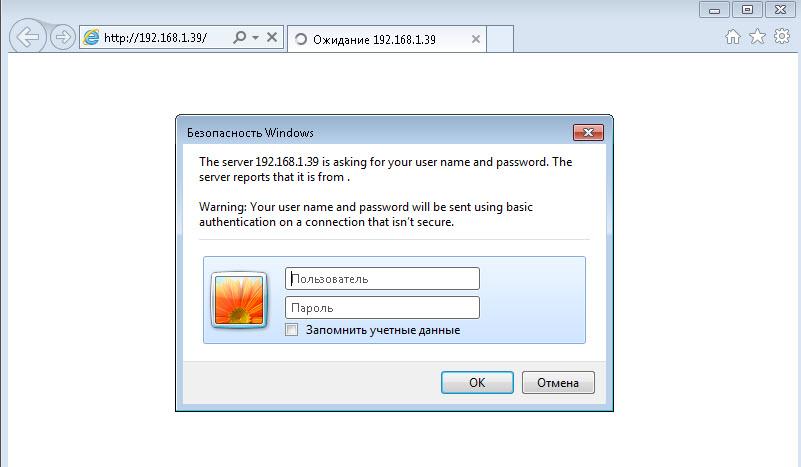
We get to the main menu of the web configurator of the phone. For convenience of setting, we immediately select the Russian language in the bottom left menu.
The menu is divided into several groups:
- Network settings (interfaces, VLAN, VPN, etc.).
- VoIP settings (SIP records and additional functions for signaling and media traffic).
- Settings for additional phone functions (phonebook settings, programmable buttons, dial plan, sound, etc.).
- Service settings (logging, reset and reboot, configuration management and software updates, etc.)
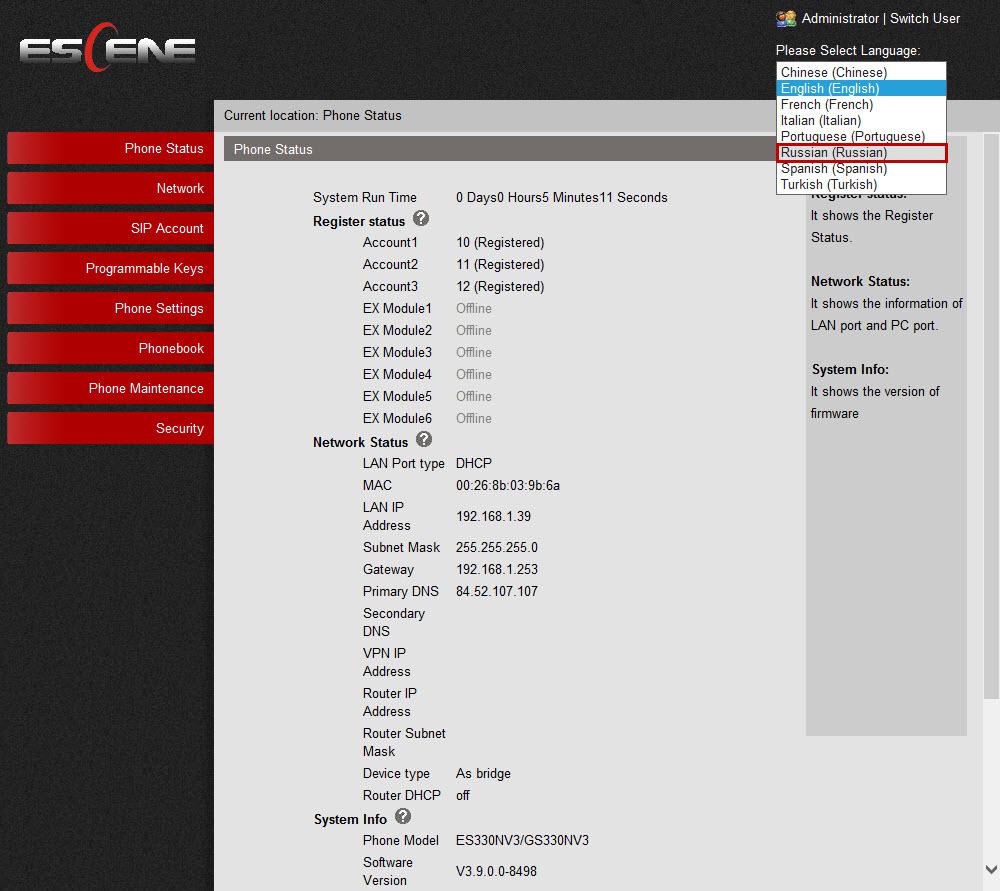
Phone status
Menu "Phone Status"

The menu refers to the service settings, allows you to get detailed information about the status of settings and statistics of the phone, such as time in operation, the status and health of the network connection, the status of the registration of SIP-lines, the firmware version and others.
Network settings
Menu "Network" -> "LAN port"
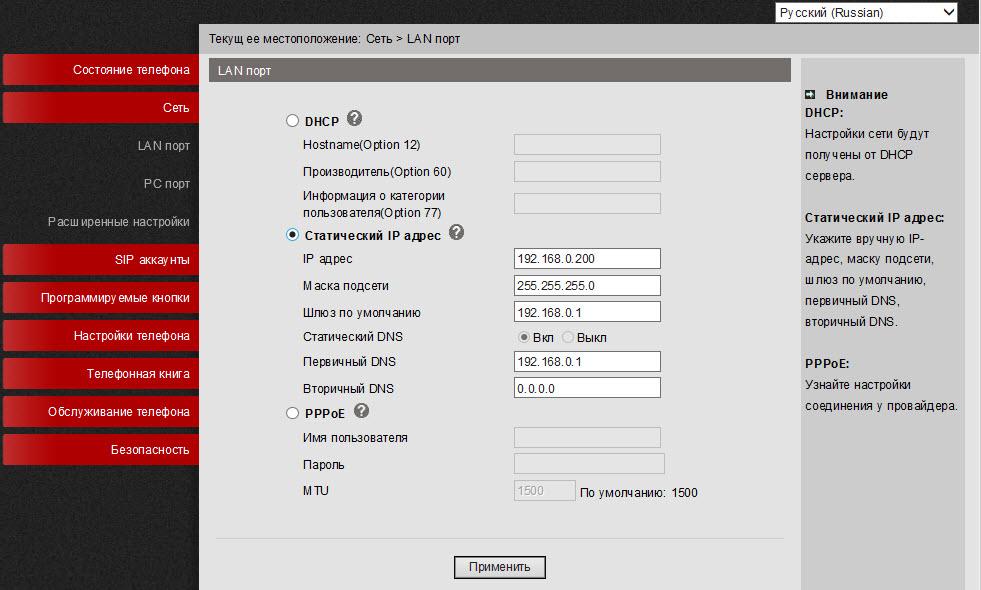
Basic Settings Tab
Here you can set one of three connection methods: by DHCP, static IP or PPPoE.
Menu "Network" -> "PC port"
L2 switching is switched on by default between the LAN and PC ports of the telephone - the “Bridge” mode. The phone can switch to L3 routing mode — a NAT address translation will start on the LAN port, an IP address will need to be configured on the PC port, and if necessary, a DHCP server must be enabled in which to set the pool of IP addresses for clients.


Menu "Network" -> "Advanced Settings"
VPN Settings tab

If you need to connect your phone via a secure VPN channel, this can be done directly from the phone, without buying additional equipment (for example, a VPN router), the phone supports L2TP and SSL VPN. This is a very useful feature for several reasons.
Firstly, if you have several phones that need to be delivered to a remote office, there is no need to buy a VPN hub at each remote location, you just need to configure the VPN client built into the phone. Further, through the tunnel to register his phone on the IP PBX in the central office.
Secondly, VPN improves security, more and more administrators are thinking about how to protect terminals that are on the Internet, two problems are becoming more acute: the danger of hacking the terminal and the difficulty of accessing telecoms operators to configure it, because often the terminal is behind NAT. Using a VPN client solves both of these problems, so this useful feature will become increasingly popular. In the example, using the VPN type L2TP, a connection to the vpn.ucexpert.ru server was created.
VLAN Settings Tab

In a corporate network, it is recommended to isolate the computer network traffic from the voice network traffic, this is most often implemented using two VLANs. The phone supports VLAN on both ports.
It is also an important setting - HTTP and Telnet ports. They should be made non-standard if the phone is on an untrusted network (for example, with an external IP address on the Internet). Also here you can configure Paging - group notification.
VoIP Settings
The phone allows you to manage a large number of SIP signaling settings and settings for RTP media traffic.
Menu "SIP accounts" -> "Account 1"
Tab "Basic"
In addition to the standard SIP account settings (SIP account) - User name (UserID), Name (AuthID) and password, there is a “Label” field, it allows you to insert an arbitrary line description that will be displayed on the phone screen.
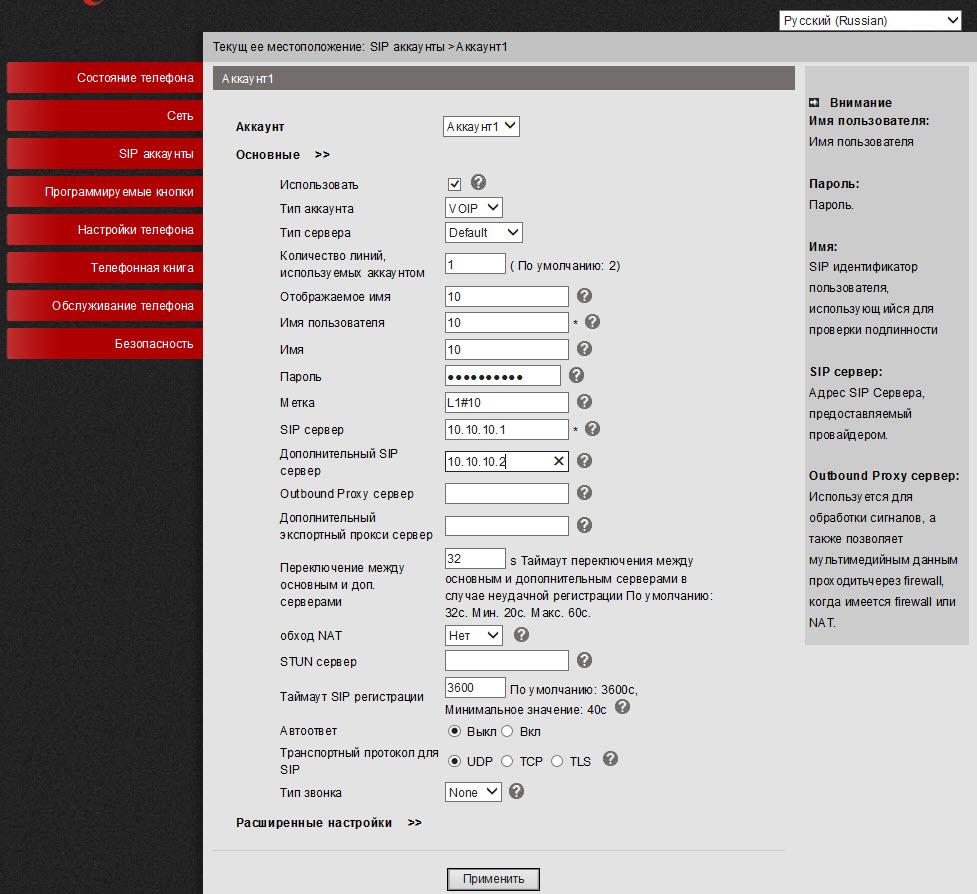
In addition to the primary IP address of the SIP server, you can add an additional IP SIP server. In case of unsuccessful registration during the timeout, which by default is 32 seconds, the address of the additional SIP server will be used for registration. The setting “Number of lines used by the account” should be equal to 1 if you need to use both lines, because the second line must be assigned to the second SIP account. If you leave the value equal to 2, then when applying the settings of the second line, the phone will display a message that there are not enough lines.
Advanced Settings Tab

Here you can specify additional settings to overcome NAT, enable DNS SRV. The phone supports encryption of RTP and SIP signaling traffic using TLS protocol.
Menu "Programmable buttons" -> "Speed dial buttons"
In this menu, you can configure the mode of operation of each of the 12 programmable buttons on the extension panel. The following modes are available:
- Asterisk BLF - Busy Lamp Field allows you to track the current state of the lines of other subscribers in real time.
- Broadsoft BLF - the same as the first point but with features for working with the Broadsoft platform.
- Speed Dial - Allows you to dial a saved number with one touch.
- Speed dial prefix - Allows you to dial a combination of numbers and then wait for the end of dialing from the subscriber.
- DTMF - allows you to send a saved DTMF combination
- SIP URI - allows you to dial a previously saved address, for example, sip: ignat@ucexpert.ru .

An example of setting the panel buttons in BLF mode for Asterisk is given at the end of the review.
Menu "Programmable buttons" -> "Line"

The “Account” selection menu can take the values Account1 / Account2 / Account3 / Any and becomes active if the button is assigned a dialing mode, for example, speed dial, DTMF or speed dial prefix.
Menu "Programmable buttons" -> "Function keys"
In this menu, you can assign an action to the function buttons of the phone if the actions they perform by default for some reason should be different. To do this, in the drop-down menu of the choice, specify the action that will be performed when you press the button.

Menu "Programmable buttons" -> "Programmable keys"
Allows you to manage the sets of soft buttons that appear on the phone screen depending on the state of the phone (handset is on, handset is off, connected, talking, etc.) This is a very useful feature that allows you to control the functions available to the user.
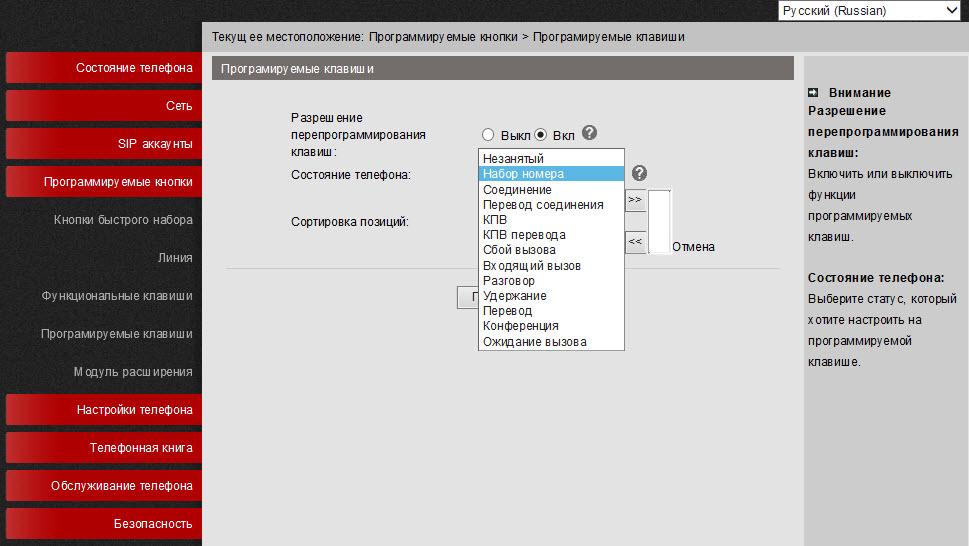
Menu "Programmable buttons" -> "Expansion module"
As for the setting of the buttons for the Escene ESM 32 expansion module, it is no different from the settings in the “Programmable buttons” -> “Speed dial buttons” menu.
In the menu "Expansion modules" -> "Expansion module 1", you must program the buttons of the first panel, all changes are applied without rebooting. An example of connecting and configuring the extension module to the phone can be in other reviews, for example, on Escene ES410-PE .
Menu "Phone Settings" -> "Basic"
Here, in the “Time Settings” tab , there are settings for time synchronization. You can select the synchronization source: SIP-server / SNTP / Manual, time zone and date format. On the other tabs, you can adjust the timeout for turning off the backlight, locking the keyboard, loading your own ringing tone, microphone volume, handset, speakerphone.
Menu "Phone Settings" -> "Features"
Tab "Forwarding VOIP calls"

The tab is set forwarding: unconditional, if the subscriber did not answer or the line is busy.
Other Features Settings Tab
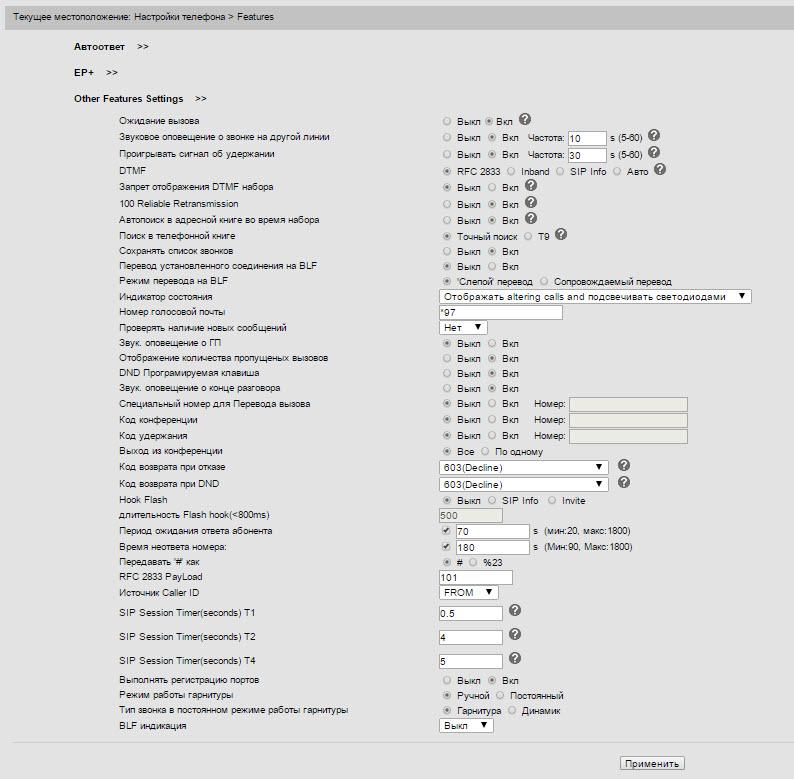
In this menu, you can configure various phone functions related to call processing and SIP signaling. If you register the SIP settings here, they will be applied to all three SIP accounts automatically.
In case the call transfer is required to be performed with a special key combination (old code), instead of the standard SIP message 302, this can be specified in the setting “Special code for call transfer”. A useful setting that allows you not to break the connection in the conference, if it left the initiator. You can set call forwarding by condition (busy and “no answer”) and unconditional. In this section, you configure the code that is transmitted when you click the Voice Mail button (the value in the Voice Mail Number field).
The important setting is “Return Code on Failure” and “Return Code at DND”, by default IP PBX returns SIP message 603 Decline, these messages can be changed to others, if necessary for correct interpretation of the reason for the release.
The important setting is DTMF type - by default it is set to RFC2833. You can turn on auto search by address book during dialing, as well as search in the phone book by the first characters or by using the predictive input method T9.
In the “ Phone Settings” -> “Features” menu there are several more tabs.
The tab “Hotline function” allows you to set up automatic dialing of the specified number immediately or with a specified delay, the “Auto Answer” tab serves to set up and select the mode of automatic answer to a call. Pickup "(the value in the" Call Pickup Code "field), you can intercept the call in three ways:
- Pressing the “Hold” button - a combination for call pickup will be sent to the IP PBX, assigned in the “Call Pickup Code” field.
- By assigning a speed dial combination to one of the extension panel buttons for call pickup.
- Using an explicit dialing combination on the phone keypad.
Menu "Phone Settings" -> "Advanced Settings"
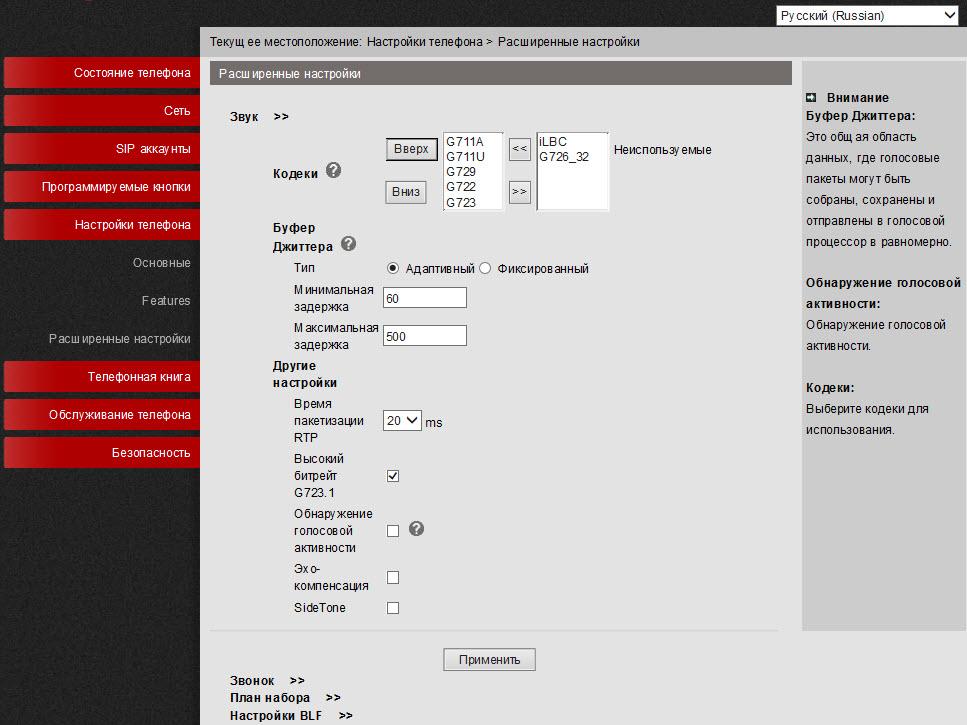
Here, in the “Sound” tab, the RTP protocol settings are set. By default, when calling, the phone claims all possible codecs. If necessary, unused codecs can be disabled. Here you can enable echo cancellation and VAD. Moreover, in the “Call” tab you can download your own ringtone. In the "Dial Plan" tab, you can create rules for modifying the dialed number before sending it to the SIP server.
Menu "Phonebook"

The phone has a built-in phone book, which is quite advanced. It allows you to store up to 300 contact entries, each of which can store up to 3 phone numbers. Entries can be made via the phone's on-screen menu using the web-based interface. To download or save an already-created phone book in XML format, use the Phone Service menu -> Update over HTTP -> XML Phone Book; here you can save or load the phone book in XML format.
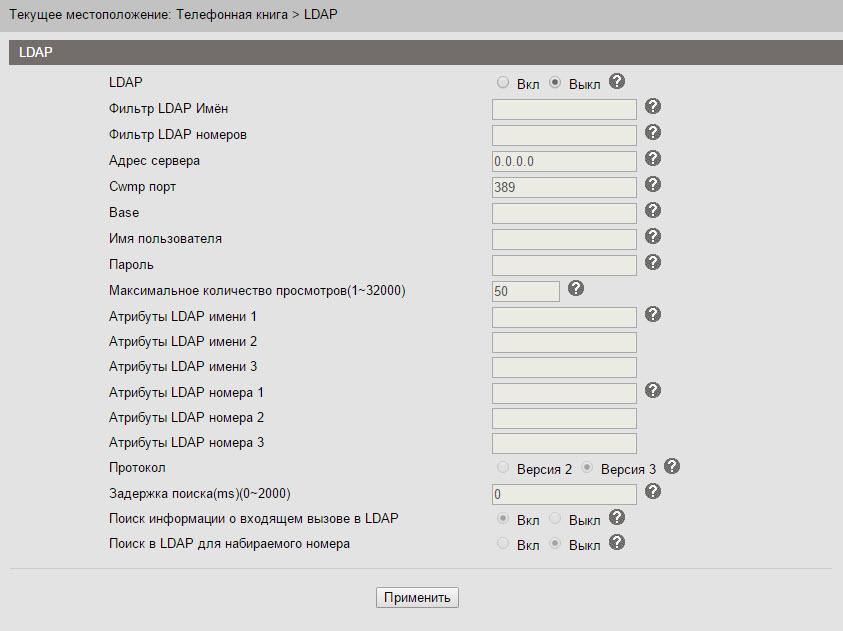
If your company uses an LDAP server, you can connect a phone to it and synchronize corporate contacts. 2 and 3 protocol versions are supported, as well as using the “LDAP Lookup For Incoming Call” and “LDAP Lookup For PreDial / Dial” settings, you can search for the contact name for an incoming and outgoing call. If the contact is in the LDAP directory, then its name will be automatically added to the number.
The phone also supports blacklists or ban lists: an unwanted phone number is added to such a list and can no longer reach you.
Also, the phone has the opportunity to automatically dial a phone number from the "Phonebook" menu. Just enter it in the appropriate field, and then by pressing the "Dial" button, the phone will call this number.
Service Settings
Menu "Phone service" -> "Basic"
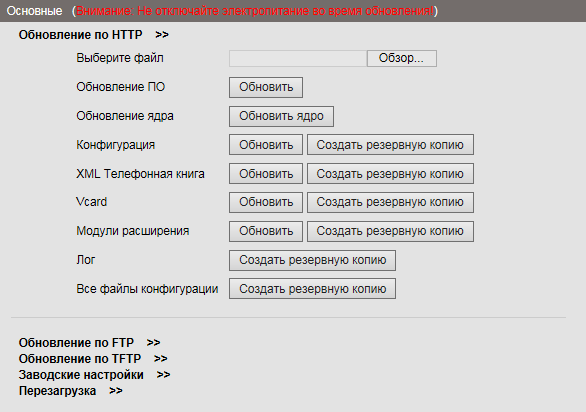
You can copy configuration files using three different protocols. FTP, TFTP and HTTP - the choice of a particular protocol is a matter of taste and convenience. Software update is extremely simple, you need to select the firmware file, then click update. If the version of the downloaded firmware of the phone is lower than the installed one, a window will appear with the inscription “Filename is illegal”. In the menu, you can also restart the phone or reset it to the factory settings.
Menu "Phone Settings" -> "Advanced Settings"

To debug the phone, you can enable logging by specifying the necessary logs. You can view them in two ways:
- In the same menu, enable sending logs to the syslog server.
- Download file c logs.
Also, the phone has the ability to collect network dumps of packets into pcap files, which can then be analyzed using a sniffer, for example, Wireshark, this is a very effective debugging tool.
To start capturing packets, click the “Start” button. When finished, click the “Finish” button. To download the received dump, click the "Create backup" button.
Also on the “Automatic Update” tab, you can configure the phone's firmware update according to the TFTP / FTP / HTTP / HTTPS protocols.
Security menu
Here you can set a username and password for the administrator and user of the phone, as well as download an SSL certificate.
Examples of phone settings
Setting up connection to IP PBX Asterisk using web-interface
Suppose we need to configure two extensions (two SIP accounts). For example, the first entry on the IP PBX Asterisk, the second on the virtual IP PBX:
IP Asterisk= 10.10.10.1 UserID=10 password= QOXZuTcZ38qlBsr SIP (Asterisk)= 10.10.10.1 In the Asterisk sip.conf configuration, this will be equivalent to:
[10] deny=0.0.0.0/0.0.0.0 secret= QOXZuTcZ38qlBsr dtmfmode=rfc2833 canreinvite=no context=from-internal host=dynamic type=friend nat=yes port=5060 qualify=yes callgroup=01 pickupgroup=01 allow=g722 dial=SIP/10 mailbox=10@device permit=0.0.0.0/0.0.0.0 callerid=device <10> callcounter=yes faxdetect=no Equivalently, when configured in the Free-PBX web interface, using the first line as an example:
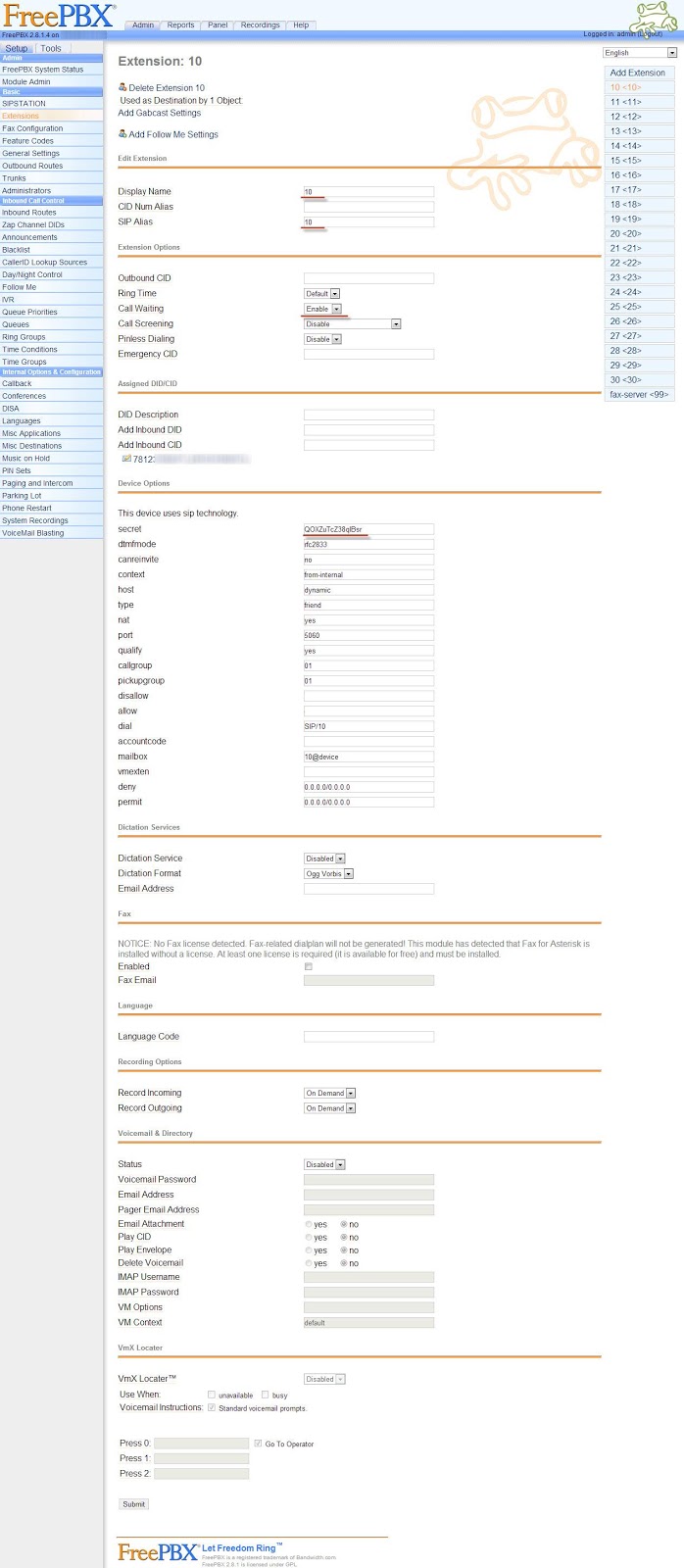

To work with Asterisk, just configure the Username (Username) = 10, password (Password) = QOXZuTcZ38qlBsr and SIP Server (SIP Server) = 10.10.10.1. You can add a label (Label) that will be displayed on the screen of the phone, in this case "L1 # 10".
You can reduce the re-registration time from standard 3600 seconds to 600 seconds, this is especially true if the IP PBX is located outside the office, for example, Virtual PBX. If the phone is on a local network and the IP PBX is on the Internet, no special settings are usually required to overcome NAT. Next, click the "Apply" button.
Exactly the same thing needs to be done with the second line, for example, the city number 78126470011 on the WestCall operator's SIP server. Let's register it on a virtual PBX with a non-standard SIP port 9966:
userid=78126470011 authid=6470011 password= eIoMzKsf sip =uc.westcall.net port=9966 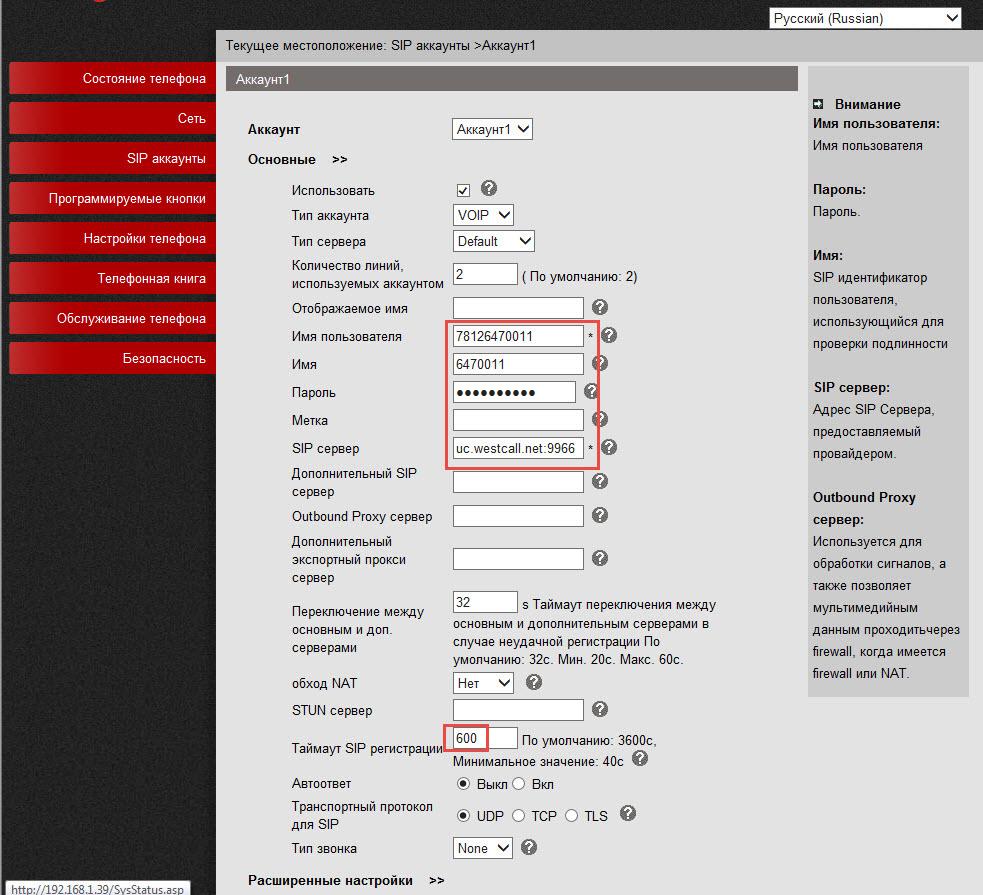
To specify a non-standard SIP port (other than 5060), you must explicitly specify it in the SIP server line: uc.westcall.net:9966. Next, click the "Apply" button.
In case of successful registration, the corresponding display will appear on the phone screen, so information on the status of line registration is available on the Status menu page:
Account 1: Registered
Account 2: Registered
In order to use the DVO buttons (transfer, hold, conference) no additional configuration is required.
Setting up the BLF
For BLF to work, you need to enable this feature on Asterisk in the Free-PBX configuration files:
In the /etc/asterisk/sip_general_custom.conf file, you need to add lines that allow subscribers to monitor the status of the lines:
notifyringing=yes notifyhold=yes For more information on setting up BLF for Escene phones, click here .
Setting up the BLF on the phone is very simple, you just need to specify the numbers for which you need to activate the BLF function, in our case it’s lines from 12 to 17:
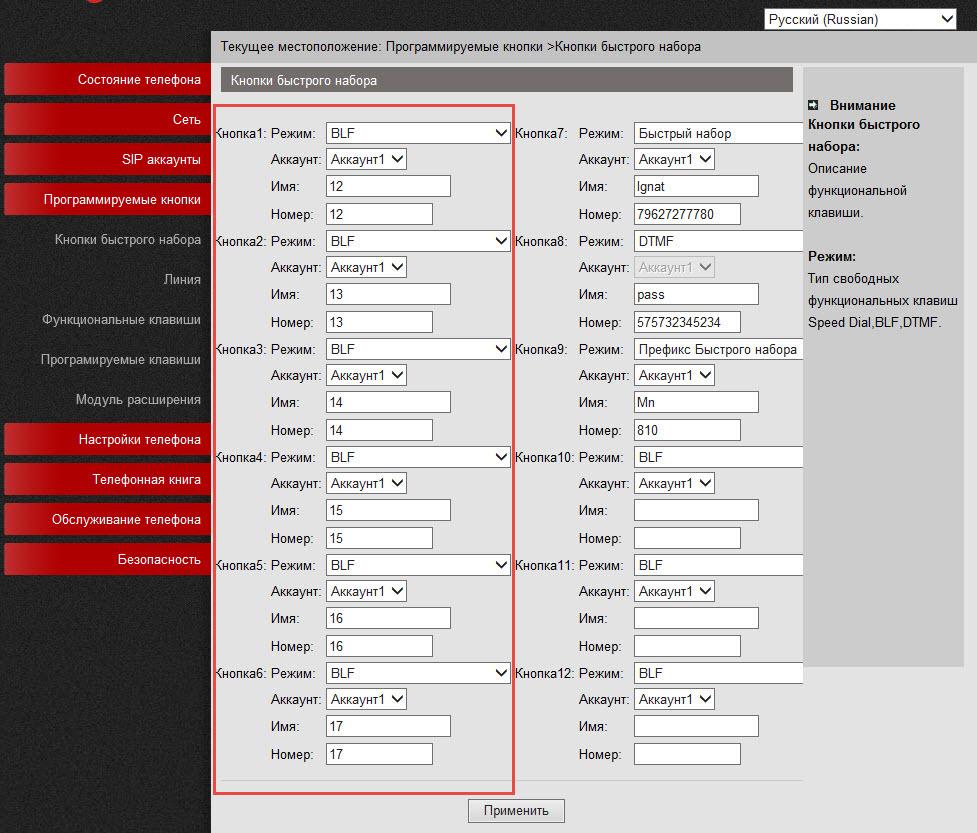
If everything is correct, then the first six buttons on the phone’s panel will become active - their status will be displayed, in my case in green, this means that the lines are free.

When you press the line button, the phone will automatically make a call to the line corresponding to this button.
findings
The Escene ES330- (P) N professional corporate phone and its Escene GS330-N gigabit version are very attractive considering their cost and functionality. This model is suitable for both secretaries and managers processing average or large number of calls, as well as those users who need an expanded set of corporate functions. The devices are easily configured, work stably, do not lose registration, have good sound quality, additional functions (transfer, hold, call forward, BLF, etc.) also work stably.
Compared with the younger model of the ES330, a larger number of functions are displayed on the hardware buttons, in addition, there are multifunctional screen buttons. All this significantly increases the convenience and efficiency of working with the phone.
The presence of a built-in programmable panel for twelve buttons, USB power, as well as three ways to connect the headset makes the phone a very attractive option for handling a large number of calls, for example, the secretary, while eliminating the need to buy a 32-button expansion panel if enough buttons. Summarizing what has been written, we can conclude that the phone is an economical and efficient product in its class.
Key features of the phone include:
- Support for two independent SIP-accounts on the phone.
- Existence of additional Ethernet port for connection to the computer and an opportunity to work in the routing mode.
- The ability to connect the headset in one of two ways: through the RJ-9 jack, 1x jack 3.5 mm.
- Most of the functions are displayed on the hardware buttons.
- Built-in programmable panel with 12 buttons.
- Support Gigabit Ethernet interfaces (modification GS330-N).
- PoE support (model ES330-PN and GS330-N).
- Power supply via USB port
- Clear LCD screen with white backlight.
- The ability to configure in addition to the network settings, SIP-accounts, speed dial buttons and redirects directly from the phone screen.
- Advanced debugging features.
- Swivel stand and possibility of mounting on the wall.
Source: https://habr.com/ru/post/267819/
All Articles